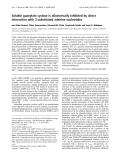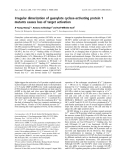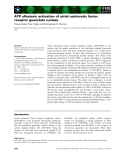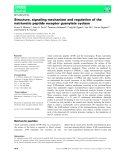
Guanylate cyclase
-
Nitric oxide (NO), the principal endogenous ligand for soluble guanylate cyclase (sGC), stimulates that enzyme and accumulation of intracellular cGMP, which mediates many of the (patho) physiological effects of NO. Previous studies demonstrated that 2-substituted adenine nucleotides, including 2-methylthioATP (2MeSATP) and 2-chloroATP (2ClATP), allosterically inhibit guanylate cyclase C, the membrane-bound receptor for the Escherichia coli heatstable enterotoxin in the intestine. The present study examined the effects of 2-substituted adenine nucleotides on crude and purified sGC. ...
 8p
8p  research12
research12
 01-06-2013
01-06-2013
 37
37
 4
4
 Download
Download
-
In rod phototransduction, cyclic GMP synthesis by mem-brane bound guanylate cyclase ROS-GC1 is under Ca 2+ -dependent negative feedback control mediated by guanylate cyclase-activating proteins, GCAP-1 and GCAP-2. The cellular concentration of GCAP-1 and GCAP-2 approxi-mately sums to the cellular concentration of a functional ROS-GC1 dimer. Both GCAPs increase the catalytic effi-ciency (kcat /Km) of ROS-GC1. However, the presence of a myristoyl group in GCAP-1 has a strong impact on the regulation of ROS-GC1, this is in contrast to GCAP-2....
 8p
8p  tumor12
tumor12
 20-04-2013
20-04-2013
 43
43
 2
2
 Download
Download
-
Guanylate cyclase-activating proteins (GCAPs) are neur-onal calcium sensors that activate membrane bound guanylate cyclases (EC 4.6.1.2.) of vertebrate photoreceptor cells when cytoplasmic Ca 2+ decreases during illumination. GCAPs contain fourEF-handCa 2+ -bindingmotifs, but the first EF-hand is nonfunctional. It was concluded that for GCAP-2, the loss of Ca 2+ -binding ability of EF-hand 1 resulted in a region that is crucial for targeting guanylate cyclase [Ermilov,A.N.,Olshevskaya, E.V.&Dizhoor,A.M. (2001) J. Biol. Chem.276, 48143–48148].
 9p
9p  awards
awards
 05-04-2013
05-04-2013
 51
51
 4
4
 Download
Download
-
Atrial natriuretic peptide (ANP) plays a major role in blood pressure and volume regulation. ANP activities are mediated by a cell surface, single-span transmembrane receptor linked to its intrinsic guanylate cyclase activ-ity. The crystal structures of the dimerized ANP receptor extracellular domain (ECD) with and without ANP have revealed a novel hormone-
 9p
9p  vinaphone15
vinaphone15
 27-02-2013
27-02-2013
 32
32
 3
3
 Download
Download
-
Atrial natriuretic factor receptor guanylate cyclase (ANF-RGC) is the receptor and the signal transducer of two natriuretic peptide hormones: atrial natriuretic factor and brain natriuretic peptide. It is a single trans-membrane-spanning protein. It binds these hormones at its extracellular domain and activates its intracellular catalytic domain.
 14p
14p  mobifone23
mobifone23
 21-01-2013
21-01-2013
 41
41
 5
5
 Download
Download
-
Atrial natriuretic peptide (ANP) and the homologous B-type natriuretic peptide are cardiac hormones that dilate blood vessels and stimulate natri-uresis and diuresis, thereby lowering blood pressure and blood volume. ANP and B-type natriuretic peptide counterbalance the actions of the renin–angiotensin–aldosterone and neurohormonal systems, and play a cen-tral role in cardiovascular regulation.
 12p
12p  cosis54
cosis54
 05-01-2013
05-01-2013
 36
36
 4
4
 Download
Download
CHỦ ĐỀ BẠN MUỐN TÌM



















